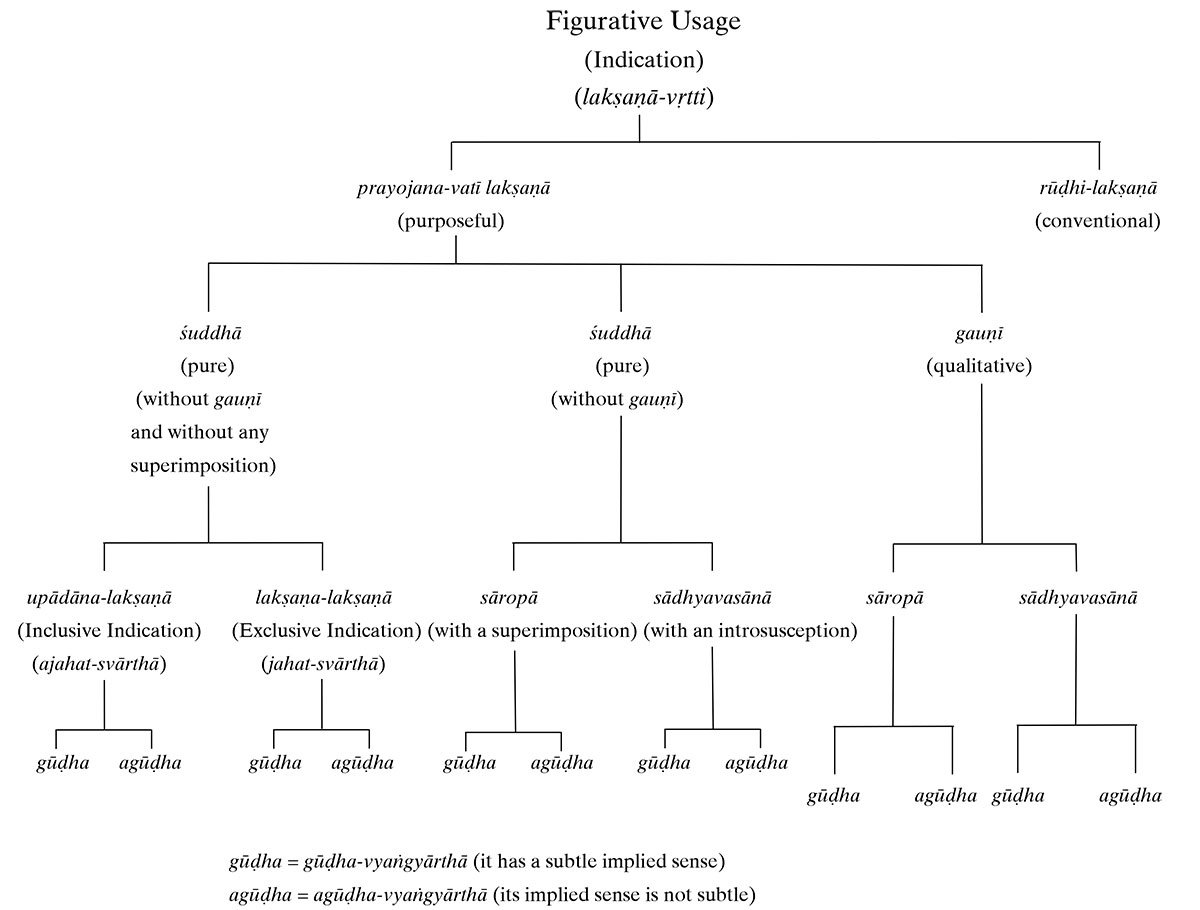Sahitya-kaumudi by Baladeva Vidyabhushana
by Gaurapada Dāsa | 2015 | 234,703 words
Baladeva Vidyabhusana’s Sahitya-kaumudi covers all aspects of poetical theory except the topic of dramaturgy. All the definitions of poetical concepts are taken from Mammata’s Kavya-prakasha, the most authoritative work on Sanskrit poetical rhetoric. Baladeva Vidyabhushana added the eleventh chapter, where he expounds additional ornaments from Visv...
Text 2.16
सङ्कलयति, लक्षणा तेन षड्-विधा ॥ २.१२d ॥
saṅkalayati, lakṣaṇā tena ṣaḍ-vidhā ||2.12d||
lakṣaṇā—Indication; tena—with that (or therefore); ṣaḍ-vidhā—sixfold.
He sums them up: Therefore lakṣaṇā has six varieties.
tenopādānādi-prakāreṇa ṣoḍhā-phalavatī. ihopādāna-lakṣaṇādiṣu bhedeṣv ādyābhyām arthāntara-saṅkramita-vācyātyanta-tiraskṛtavācyau madhyamābhyāṃ rūpaka-prathamātiśayoktī śeṣābhyāṃ hetv-alaṅkāraś ca nirūpayiṣyante.
With the varieties beginning from Inclusive Indication, purposeful figurative usage has six categories. In this regard, of the varieties of Indication, the arthāntara-saṅkramita-vācya-dhvani (4.1) (5.2) and the atyanta-tiraskṛta-vācya-dhvani (4.1) (5.2) will be described by means of the first two respectively (Inclusive Indication and Exclusive Indication); the rūpaka ornament (metaphor) (10.44) and the first variety of the atiśayokti ornament (10.84) will be described by means of the middle two (gauṇī sāropā and gauṇī sādhyavasānā); and the hetu ornament (cause) (11.21) will be described by means of the last two (śuddhā sāropā and śuddhā sādhyavasānā).
Commentary:
Mammaṭa’s elaboration on the above sūtra is simply: ādya-bhedābhyāṃ saha, ““With that” means “with the first two varieties”” (Kāvya-prakāśa 2.12).
The six kinds of Indication, with examples, are as follows:
✡ śuddhā upādāna-lakṣaṇā (pure Inclusive Indication): “The spears enter,” “The song of the flute,”
✡ śuddhā lakṣaṇa-lakṣaṇā (pure Exclusive Indication): “The cowherd settlement is on the Ganges,”
✡ gauṇī sāropā (qualitative superimposition): “The outsider is an ox”,
✡ gauṇī sādhyavasānā (qualitative introsusception): “the ox”,
✡ śuddhā sāropā (pure superimposition): “Ghee is longevity”,
✡ śuddhā sādhyavasānā (pure introsusception): “the longevity”.
However, in his commentary on the above sūtra, Viśvanātha Kavirāja says these six categories apply both to purposeful figurative and to conventional figurative usage, for a total of sixteen varieties of Indication.[1] Viśvanātha Kavirāja’s eight basic types of figurative usage, whether conventional or purposeful, are as follows (sixteen in total):
✡ śuddhā sāropā upādāna-lakṣaṇā
✡ gauṇī sāropā upādāna-lakṣaṇā
✡ śuddhā sādhyavasānā upādāna-lakṣaṇā
✡ gauṇī sādhyavasānā upādāna-lakṣaṇā
✡ śuddhā sāropā lakṣaṇa-lakṣaṇā
✡ gauṇī sāropā lakṣaṇa-lakṣaṇā
✡ śuddhā sādhyavasānā lakṣaṇa-lakṣaṇā
✡ gauṇī sādhyavasānā lakṣaṇa-lakṣaṇā.
For the details, consult Bhakti-rasāmṛta-śeṣa.
Figurative Usage
(Indication) (lakṣaṇā-vṛtti)

prayojana-vatī lakṣaṇā (purposeful);
rūḍhi-lakṣaṇā (conventional);
śuddhā (pure) (without gauṇī and without any superimposition);
śuddhā (pure) (without gauṇī);
gūḍha (qualitative);
upādāna-lakṣaṇa (Inclusive Indication);
lakṣaṇa-lakṣaṇā (Exclusive Indication);
sāropā (with a superimposition);
sādhyavasānā (with an introsusception);
sāropā;
sādhyavasānā;
gūḍha...agūḍha...
Footnotes and references:
[1]:
ṣaḍ-vidheti, rūḍhi-prayojanopādāna-lakṣaṇāropādhyavasānaiḥ ṣaḍbhir upādibhir dvidhā uktā, ṣoḍaśa-prakārā yasyāḥ sā ṣaḍ-vidhā, na tu ṣaṭ-prakārā. ādya-bhedābhyāṃ prathamoktopādhibhyāṃ rūḍhi-prayojanābhyāṃ saha yadvā prathamaṃ rūḍhi-prayojanābhyāṃ sāmānyata uktaṃ lakṣaṇā-dvayaṃ bhidyate, ādya-bhedābhyām iti bhedāv upādāna-lakṣaṇalakṣaṇe tābhyāṃ saha iti grantha-saṅgatiḥ (Kāvya-prakāśa-darpaṇa 2.12).
